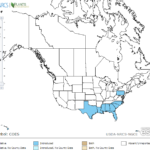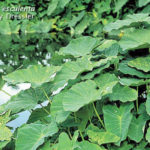Colocasia esculenta
Non-Native
USDA, NRCS. 2018. The PLANTS Database (http://plants.usda.gov, 28 March 2018). National Plant Data Team, Greensboro, NC 27401-4901 USA.
Illustration courtesy of University of Florida/IFAS Center for Aquatic and Invasive Plants. Used with permission.
What is Water Taro?
Physical Characteristics
Leaves:
- Large, up to 6 feet long
- Leaf stalks attached a few inches away from the base of the leaf
- Dark green in color
- Arrow shaped
- Long leaf stalks
Seeds:
- Bulb-like
- Leaf stalks grow directly from seeds
Stem:
- Rhizomes
- Up to 4 feet tall
Where Does it Grow?
Non-Native
Water taro is native to Africa and can be found in swamps and along the banks of streams.
Pros and Cons of Water Taro
Many people in Central and South America use the tubers of water taro for food. This plant is non-native to the United States, and tends to disrupt the ecosystem by pushing the native species out of their habitat.
This plant is not native to North America, but has naturalized in much of the United States. While it is not illegal to possess this plant in Texas, it should not be introduced into new water bodies and should be treated with herbicide when present.



